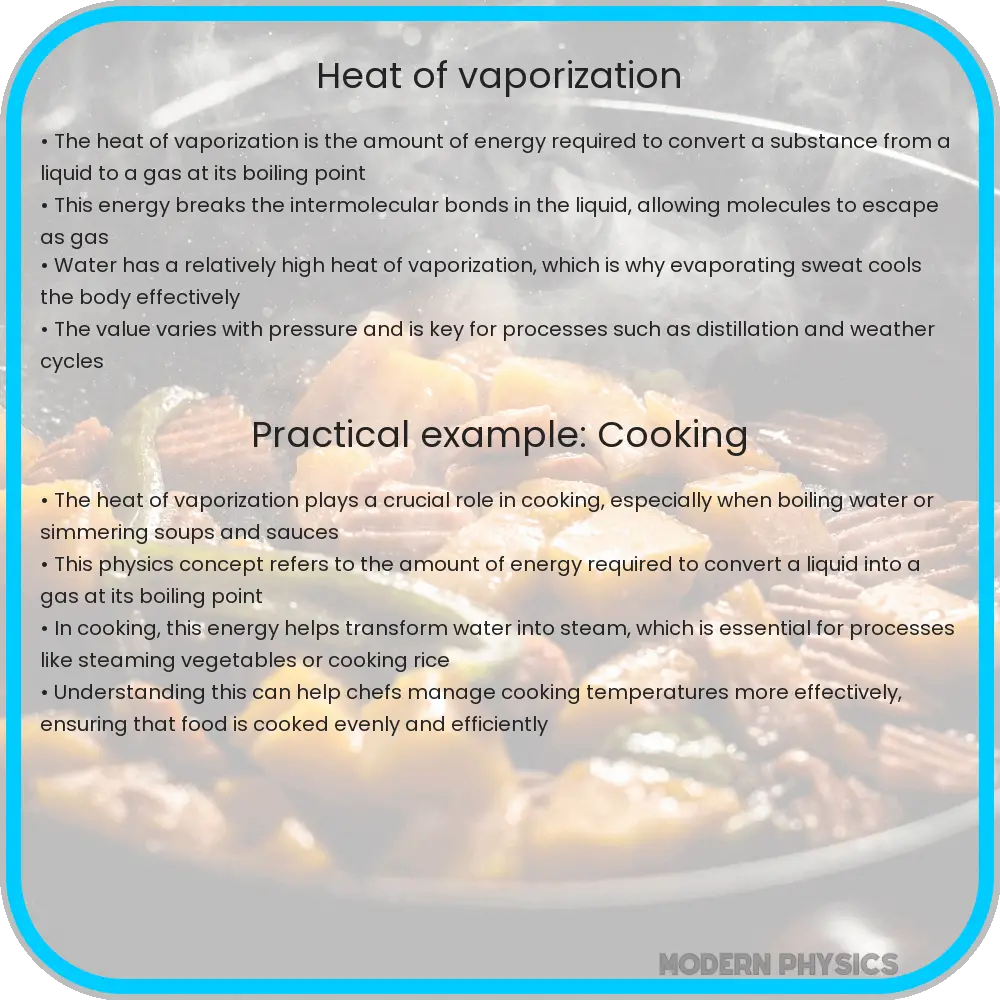Explore the heat of vaporization in thermodynamics: its calculation, factors, applications in engineering, meteorology, and material science.

Understanding the Heat of Vaporization in Classical Thermodynamics
Heat of vaporization, a fundamental concept in classical thermodynamics, represents the amount of energy required to convert a substance from its liquid phase to its gaseous phase at a constant temperature and pressure. This thermal energy breaks the intermolecular forces in the liquid, allowing the molecules to escape into the gas phase. The understanding of this process is crucial in fields ranging from meteorology to chemical engineering.
Factors Affecting Heat of Vaporization
Several factors influence the heat of vaporization of a substance. Primarily, it depends on the strength of the intermolecular forces within the liquid. Substances with strong intermolecular forces, like hydrogen bonding in water, require more energy to vaporize. Secondly, the molecular weight of the substance plays a role. Heavier molecules generally have a higher heat of vaporization due to the greater energy needed to overcome their inertia.
Calculating the Heat of Vaporization
The heat of vaporization (\( \Delta H_{vap} \)) can be calculated using the Clausius-Clapeyron equation, which relates the vapor pressure of a liquid to its temperature. The equation is given by:
\[ \ln(P_2/P_1) = -\Delta H_{vap}/R \cdot (1/T_2 – 1/T_1) \]
where \( P_1 \) and \( P_2 \) are the vapor pressures at temperatures \( T_1 \) and \( T_2 \) respectively, \( \Delta H_{vap} \) is the heat of vaporization, and \( R \) is the universal gas constant.
Applications in Real-World Scenarios
The concept of heat of vaporization has practical applications in various industries. In meteorology, it helps in understanding the energy exchange processes in the atmosphere, influencing weather patterns and climate. In the chemical industry, it is vital in processes like distillation and in designing cooling systems. Additionally, it plays a significant role in the energy sector, particularly in power plants where steam turbines are used for electricity generation.
Understanding the heat of vaporization not only provides insights into the physical properties of substances but also aids in the development of efficient and sustainable industrial processes. The next section will delve deeper into the theoretical aspects and the practical implications of this concept in various fields.
Theoretical Aspects of Heat of Vaporization
In classical thermodynamics, the heat of vaporization is intrinsically linked to the concepts of enthalpy and entropy. Enthalpy change during vaporization reflects the energy absorbed by a substance to overcome atmospheric pressure and intermolecular forces. Entropy, on the other hand, measures the disorder or randomness introduced during the phase transition. The increase in entropy is significant as the orderly liquid state transforms into a more disordered gaseous state.
Practical Implications in Various Fields
In engineering, particularly in the design of heat exchangers and boilers, the heat of vaporization is crucial for efficiency calculations. In the food industry, it influences techniques like freeze-drying and evaporation, crucial for food preservation. Additionally, in environmental science, understanding the heat of vaporization of water aids in modeling evapotranspiration processes, which are vital for ecological balance and water cycle studies.
Advanced Applications and Research
Advanced research in nanotechnology and material science frequently utilizes the concept of heat of vaporization. Nanoscale materials often exhibit unique phase transition behaviors, influencing their heat of vaporization. These insights are pivotal in developing innovative materials with specific thermal properties. In pharmaceuticals, the concept assists in designing drug delivery systems, especially in aerosol therapies where vaporization characteristics are essential.
Conclusion
The heat of vaporization is a cornerstone concept in classical thermodynamics with extensive applications across various scientific and industrial domains. Its importance lies not just in the theoretical understanding of phase transitions, but also in its practical implications in engineering, environmental science, meteorology, and materials science. A thorough grasp of this concept enables professionals and researchers to innovate and optimize processes, contributing to advancements in technology and a deeper understanding of the natural world. As we continue to explore the frontiers of science and technology, the principles governing the heat of vaporization will remain fundamental in shaping the future of innovation and environmental stewardship.
